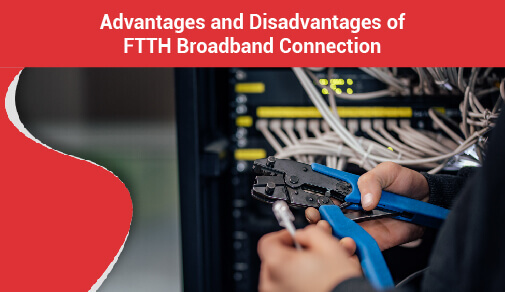The Advantages and Disadvantages of Fiber-to-the-Home (FTTH) Broadband
Saturday, Jun 08, 2024 · 4 minutes


THE ADVANTAGES AND DISADVANTAGES OF FIBER-TO-THE-HOME (FTTH) BROADBAND
Saturday, Jun 08, 2024 · 4 minutes
In today's digital age, having fast and reliable internet is essential for both work and leisure. Fiber-to-the-Home (FTTH) broadband is a type of internet connection that utilises fiber optic cables to deliver high-speed internet directly to homes. In this article, we will explore the advantages and disadvantages of FTTH broadband, helping you decide if this technology is right for you.
Fiber-to-the-Home (FTTH) broadband is a technology that provides internet access by running fiber optic cables directly to individual residences. This differs from traditional broadband services that use copper cables, resulting in faster and more reliable internet connections. With FTTH broadband connection, users can experience speeds of up to 1 gigabit per second, making it ideal for streaming, gaming, and working from home.
Light moves down a fiber optic cable by bouncing off the walls of the cable repeatedly. With continued internal mirror-like reflection, each light particle (photon) bounces down the pipe. The light beam passes down the centre of the cable. The middle of the cable and the glass framework are an integral part of the fiber. Another layer of glass wrapped around is the cladding, to keep the light signals within the fiber optic cable.
ACT Fibernet has analyzed real-time feedback from users in its innovation labs and continuously worked to improve its traffic patterns, data centers, last-mile connectivity, and in-home experience. With continuous iterative improvements in every aspect of technology, from network architecture, fast convergence, scalability, and adoption of the new evolution of technologies around the globe – ACT SmartFiber® is not just a wire into your home, but a gateway to superior internet usage experience.
With ACT SmartFiber, users will always have a seamless connection without lags, buffers or jitters. With the fast changing world, choose smart fibernet to ease your internet life.
In conclusion, when you are looking for the best FTTH providers, Fiber-to-the-Home (FTTH) by ACT Fibernet broadband offers numerous benefits of FTTH such as high-speed internet, reliability, and future-proof technology. However, it also comes with drawbacks including cost, fragility, limited provider options, and installation challenges. Before deciding to switch to the best FTTH providers, consider these factors carefully to determine if this technology aligns with your needs and budget.
50

The New Social: How High-Speed Internet is Redefining 'Quality Time' with Friends and Family
Read more150

How ACT SmartWi-Fi is Redefining Home Internet in 2025: The Age of AI-Powered Seamless Connectivity
Read more79

From Bandwidth to Intelligence: How AI Is Redefining Business Demands from ISPs
Read more
A referral link has been sent to your friend.
Once your friend completes their installation, you'll receive a notification about a 25% discount on your next bill
![]() Please wait while we redirect you
Please wait while we redirect you

![]() One of our representatives will reach out to you shortly
One of our representatives will reach out to you shortly

One of our representatives will reach out to your shortly
![]() Please wait while we redirect you
Please wait while we redirect you

Please enter your registered phone number to proceed

Please enter correct OTP to proceed


Dear customer you are successfully subscribed
Please wait while we redirect you

Your ACT Shield subscription has been successfully deactivated

Dear user, Your account doesn't have an active subscription

Dear customer Entertainment pack is already activated.
Please wait while we redirect you